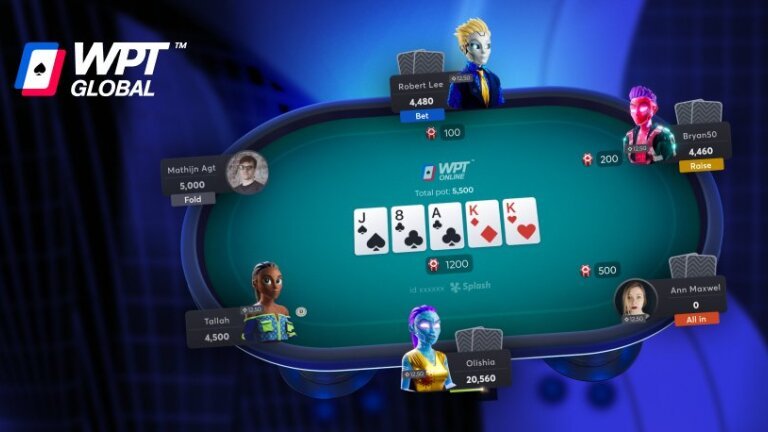Poker Strategy: Beginner's guide to online poker!
If you are new to poker and unfamiliar with the basic rules of this card game, this article is for you. First, we’ll discuss the most popular poker variant; Texas hold’em’s rules; including the gameplay, hand strength and different game variants, such as cash game and tournament play.

Poker gameplay
The game is played with a 52-card French deck, usually between 2-10 players at the table. Everyone is dealt two hole cards (face down, only available to the individual player) and five community cards in three stages (face up, common cards available to all the players). The rounds are called "street", namely pre-flop, flop, turn and river. Each street consists of one betting round, clockwise. The dealer position determines the betting order. Each street starts with the leftmost player from the button (that's why pre-flop the player left to the dealer posts the small blind). The action is granted by posting blind bets according to the positions that rotate after each hand. The goal is to make the best possible holding according to hand strength or make everyone else fold by betting before the showdown. Finally, the showdown is where the hand's winner is decided by hand ranking.
The possible action a player can take is to fold (abandon the hand), check (which is equivalent to passing and only available if the player contributed at least the same amount of chips as the last bet on that street), betting (putting extra chips to the pot), raising (to increase the pot size when a betting has already occurred in that street). Texas Hold 'em nowadays is played in a No Limit version, meaning players can put any bet, even all their chips, into the pot at once. This is the so-called all-in.
The winner of a hand might be determined in two ways. First, if a player bets and all the others fold, the pot is given to the last bettor without showdown. A showdown occurs if the last bet was called at least by one player. The highest hand wins the pot according to hand rankings. There might be cases where players split the pot due to the same holdings. On each occasion, the five best cards determine hand strength. Even though both or all the players have the same hand in value, a higher pair, a higher straight, a higher kicker, etc., will determine the winner.
Importance of Positions
An important concept is the position, referring to the players’ seat relative to the dealer. A player’s position determines what hands are profitable to play, which player will have a positional advantage (the player in position will have more information about the other(s) hand strength), etc.
The positions are divided into three main categories, according to full ring (9-10 player) games. However, the short-handed (5-6 players) variants are the most popular nowadays. In the pictures below, you can find the differences (basically each type of position is represented but with fewer seats).

9-handed position types and names
It’s a good idea to familiarize yourself with the names, as the players on forums or most articles on the topic often use these terms.
The abbrivations are the following:
|
Early Position(s)
|
UTG – Early Position or Under the Gun |
UTG+1
|
UTG+2
|
|
Middle Position(s)
|
MP - Middle Position
|
MP+1 – also known as the Low Jack
|
|
|
Late Position(s)
|
HJ - High Jack
|
CO - Cut Off
|
BTN - Button
|
|
The blinds |
SB - Small Blind
|
BB - Big Blind |
|

6-handed positions
Poker hand strength
In Texas Hold’em, a player’s hand is determined by the five best cards he can make, combining his two hole cards and the five community cards. The player might use both, one or none of the hole cards.
The hand strength is based on the mathematical possibility of each holding. Therefore, the more unique/rare the hand is, the higher it is in the ranking.
|
Name |
Description |
Example |
|
High card |
A hand that has no connectivity at all. The highest hand will determine the strength. |
|
|
One pair |
Numerically matching cards will give a pair. |
|
|
Two pair |
When two different pairs are in the same hand.
|
|
|
Three of a kind |
Three numerically matching cards will give a three of a kind, also known as drill or set, in certain circumstances.
|
|
|
Straight |
Five cards in sequential order give a straight. The suits are irrelevant. |
|
|
Flush
|
Five cards of the same suit give a flush. The order is irrelevant. |
|
|
Full House
|
A combination of a three of a kind and a pair. |
|
|
Four of a kind |
Any four numerically matching cards, also known as quads.
|
|
|
Straight flush |
A combination of a straight and a flush. Five cards of the same suit in sequential order.
|
|
|
Royal flush |
The best hand in the game, an Ace-high straight flush. Starting from ten, jack, queen, king and ending with an ace.
|
|
The main poker game tpyes
Cash Game
To this day, one of the most popular game types is the cash game. Players buy in real money and play with chips of the equivalent amount. Tables themselves determine the stake players are playing in and the amount they might buy in, somewhere between 20 – 200 big blinds. However, this amount varies by the poker room. The possibility of adding any amount, even if you lost the whole stack earlier, makes it a popular and „never-ending” game unless most players run out of money.
Tournament Play
This type is similar to other competitions in the sense that players start with an equal amount of chips for their buy-in. Once they run out of chips, they are out of the tournament. However, numerous variants nowadays allow one or multiple rebuys, add-ons, etc., altering the most profitable strategies.
Unlike cash games, where the table determines the stake, in tournaments, the blinds increase by the time to force action and end the tournament in a reasonable time frame.
In a tournament, either the house offers a guaranteed prize pool or simply the players’ buy-ins add up the prize pool, and it is awarded to the top ~5-15% of the players, where the winner usually scoops the most significant chunk ~15-50% of the whole prize pool. In cash games, there are no such ultimate winners. Anybody can leave the table anytime, with the number of chips (=amount of money) collected up to that point.
Summary
You might have heard the following: „Poker takes 5 minutes to learn but a lifetime to master”. The rules are simple and straightforward. You need to make the best possible hand by showdown, combining the two hole cards and the five community cards dealt, or make everyone fold during the betting rounds (pre-flop, flop, turn and river). Next, we discussed the gameplay; the dealer’s position determines the order of players to act. Finally, the hand ranking defines the winner of the hand.
There are different game types which require different strategies. In this article, we mentioned the two most common; cash games for those who play for real money in real time and tournaments where players start with the same amount of stacks and try to win all the chips from the others to win the prizes at the end.
Hopefully, by this point, you are familiar with the basic rules of this beautiful game. So, which type will you choose? Will you try yourself in cash games or stick to the competition in a tournament? Either way, you decide; good luck at the tables!
To learn more about poker strategy, check out our Poker Strategy section.




























0 comments